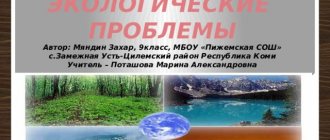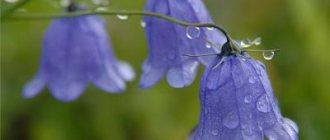The following research topics on ecology are relevant and intended for schoolchildren of any grade (also for grades 9, 10 and 11) who are interested in environmental problems and studying the causes of its decline and methods for its improvement.
In the presented rather interesting topics of research work on ecology, it is expected to reveal the problems of pollution of the environment, soil, atmosphere, water, plants, and animal habitats.
Also, the topics of environmental projects touch upon the problem of healthy eating, GMOs, cell phones, waste disposal, and the problem of homeless animals, which makes the research work of schoolchildren diverse and interesting.
For school students, the topics of environmental research projects presented on the page are currently among the most relevant and address the most important environmental problems of our time.
Topics of research projects in ecology
Topics of student projects on ecology:
Highway, snow, plants and soil. A car is a source of chemical pollution of the atmosphere. Road transport in the city: problems and ways to solve them. The ABCs of proper nutrition Nitrogen as a necessary biogenic element. An aquarium is a closed ecosystem. Aquarium is an artificial ecosystem in the Amphibian house in environmental monitoring. Analysis of water quality and the condition of the city’s water intake structures. Analysis of the quality of water taken from the river for educational and research purposes. Analysis of drinking water in the city and its impact on health. Analysis of natural sources in the area Analysis of the family's nutritional patterns. Anthropogenic influence on the life activity of bees in the territory. Anthropogenic influence on steppe ecosystems. Arithmetic and geometric progressions in the life around us. Nuclear energy - pros and cons. Stray dogs in the city. Stray dogs in the urban environment and a danger to human health. Stray dogs as an element of the ecological environment of a metropolis. Bioindication studies of areas with varying degrees of atmospheric pollution. Bioindication of gas and smoke pollution based on the condition of pine needles. Bioindication of air pollution based on a set of characteristics of Scots pine. Bioindication of environmental pollution based on a set of characteristics of Norway spruce. Bioindication of soils Household chemicals in our home and alternative cleaning methods. Household waste and problems of its disposal (a specific example). Video ecology of a river valley (a specific example). Species composition and numbers of waterfowl and semi-aquatic birds during the autumn migration period at the mouth of a river (pond). Types of water pollution and purification methods based on physical phenomena. Does coal dust affect the plants of the steppe ecosystem? The influence of nitrogen fertilizers on the formation of mint biomass. The influence of anthropogenic factors on the meadow ecosystem. The influence of external factors on seed germination (using the example of flower seeds). The influence of exhaust gases on plants in our area. The influence of the urban environment on the condition of plants (using the example of studying the growth and development of lilac shoots). The impact of railway transport on human health (using specific examples). The influence of green spaces in the school area on the air condition. Effect of cell phone radiation on guppy fry. The impact of climate change on living nature The impact of ionizing radiation on living organisms. The influence of computer addiction on the performance of students in specific classes. The influence of mobile phones on the human body.
Research work on environmental education
Municipal budgetary educational institution "Sosnovo-Ozersk secondary school No. 1"
Research work
on environmental education
Performed by: Sofia Bersanova, student of grade 2 “b” supervisor: Inna Vladimirovna Dulgarova, primary school teacher
year 2014
Introduction
Justification of the problem
The environmental problem is currently relevant. Humanity is facing an environmental catastrophe. The reason for the environmental violation was the indifferent attitude of people towards the world around them. Man is on the verge of an ecological crisis.
During nature excursions, people break tree branches, destroy insects, and leave trash behind. Some of them try to return from the forest with armfuls of field and forest plants. In spring, people often set fire to dry grass.
Today, the problem of increasing the environmental culture of society is relevant. The entire society is concerned about the conservation of natural resources. If people do not develop the foundations of an ecological culture, then in the future they will not be able to protect our planet from irreversible environmental consequences. We must remember that we do not inherit natural resources from our ancestors, but borrow them from our descendants. By environmental education of children, we understand, first of all, the education of humanity, i.e. kindness, a responsible attitude towards nature, and towards the people who live nearby, and towards descendants who need to leave the earth suitable for a full life.
Hypothesis
I put forward a hypothesis: if you work with younger schoolchildren within the framework of the environmental education system, with the organization of cognitive, practical and research activities, then you can achieve a significant increase in the environmental culture of schoolchildren.
The following research objectives were identified:
- Analysis of scientific and methodological literature on the problem.
- Conducting a pedagogical experiment.
- Development of a system of work on environmental education
- Development of a package of methodological support for the implementation of a system of work on environmental education.
The following methods were used during the work:
- analysis of scientific, methodological and popular literature;
- generalization and analysis of teachers' work experience;
- statistical data processing.
Target
The system of work I propose is the formation of the foundations of the ecological culture of junior schoolchildren. As a result of the implementation of my activities, I plan to achieve specific goals, namely: expanding environmental knowledge among children, students learning the rules of behavior in nature, involving children in useful activities to study the nature of their native land and protect it.
Tasks:
1. Expand and deepen children’s knowledge about individual phenomena and objects of the environment.
- Form an emotional perception of nature.
- Learn the rules of behavior in nature.
- To form the basis of understanding the need for careful treatment of natural objects.
- Work with parents to maintain family interest in environmental issues of their native land.
2.2. Factors shaping ecological culture in works
modern teachers
IN
Currently, work on the problems of environmental education continues. A number of researchers note that environmental education is often carried out not comprehensively, but one-sidedly, without using all the possibilities. Scientists believe that environmental culture is manifested in a responsible attitude towards nature.
L.P. Pechko believes that environmental culture includes:
- culture of students' cognitive activity
- work culture that is formed in the process of work. At the same time, environmental, aesthetic and social criteria are taken into account when representing the historical inevitability of the emergence of environmental problems
In the fourth block of the model, the author includes pedagogical means with the help of which environmental education of the individual is carried out. This is educational content, methods, visual aids, forms of organizing the educational process
2.4. Pedagogical foundations for the formation of ecological culture
IN
in his article “Ecology of Personality” Academician B.T. Likhachev envisions the development of a number of related scientific areas. Among them, he highlights such as environmental psychology and pedagogy, environmental psychophysiology. Based on them, recommendations can be developed for organizing a child’s lifestyle, overcoming crisis phenomena associated with disruption of the ecological balance (oxygen starvation, developmental delays, outbreaks of aggressiveness and cruelty towards animals and each other, etc.). Academician B.T. Likhachev notes that environmental consciousness requires reinforcement with a feeling, an emotionally holistic, deeply moral attitude towards nature, society, and people. The entire moral orientation of a child should be focused on the development of such feelings and states as love and excitement of conscience. The natural basis for the process of such education is the child’s relationship with the environment that objectively develops at different age periods. In children of preschool and primary school age, they are realized on an unconscious basis. Children, without realizing it, are not separated from the external environment, and feel like a natural part of nature. An intuitive mutual feeling and even mutual understanding are established between children, animals and plants. The child is open to perceive and assimilate the ecological rules of these relationships and turn them into his habits. Thus, environmental culture in modern conditions is one of the leading components of personality. Carrying out specific tasks in various areas of environmental management;
- a culture of spiritual communication with nature. It is important to develop aesthetic emotions here.
2.3 Model for the formation of a responsible attitude
towards the natural environment
according to A.N. Zakhlebny
The model consists of four blocks. In the first, the most important factors are named that determine the formation of a person’s properties, his worldviews, beliefs, and actions.
To solve the problems of environmental education, the following values acquire special importance: the ecological quality of the human environment (natural, transformative, artificial), natural resources and products made from them; standards and unique natural objects; cultural monuments.
The second factor that determines a person’s readiness for activity is his ideal attitude (and behavior) towards the natural environment. The development of value judgments in schoolchildren is an important factor in developing the readiness and ability to act to protect the natural environment. Moral beliefs, which psychologists consider moral principles, become the motives for human behavior. The second block of the model under consideration shows the manifestation of the student’s personality traits in specific types of activity and behavior. A responsible attitude is evidenced by:
—- culture of individual behavior in the natural environment;
- active participation in socially useful work to protect, care and improve the environment, in promoting the ideas of nature conservation
In the third block of the model A.N. Zahlebny shows the “channels” through which the teacher influences the student’s personality, his feelings and intellect. Gradually developing the intellectual abilities of an individual, it shapes his worldview. As a result of intellectual development,
3.1 Formation of ecological culture of junior schoolchildren
The formation of an ecological culture among junior schoolchildren is possible only if there is an interconnection between different types and types of activities. A variety of activities gives schoolchildren the opportunity to acquire in-depth knowledge about the connections between man and nature, see environmental problems in real life, and learn simple nature conservation skills.
A variety of student activities are implemented in all types of classes: individual, group, mass. Individual lessons involve students making observations of both individual species of plants, animals, mushrooms, etc., and natural communities located in the vicinity of the school, about the mutual influence of humans and wildlife. In individual lessons, the most valuable observations are those that lead the student to conclusions about the importance of living organisms in human life, an assessment of their condition in the area under study, and generate a desire to improve the human environment through their work: to plant trees on the street, feed birds in winter.
Individual work is closely related to introducing younger schoolchildren to reading and discussing books and articles in magazines about nature conservation.
In the formation of the ecological culture of junior schoolchildren, mass activities play a huge role: holidays, matinees, role-playing games on environmental topics.
I organize my work on environmental education according to the following system:
- working with classmates
- I work with parents
- interacting with primary school teachers
4. I ensure that students attend extracurricular activities on environmental education.
Work with children
To identify the level of environmental culture, a testing experiment was conducted: children were asked questionnaire
(see Appendix 1). The survey was conducted using the interview method. The data obtained during the survey are presented in graphs and diagrams. (See Appendix 2)
Diagram 1
Students' answers to the question: What is nature?
Students' answers to the question: What is nature? As can be seen from the graph, most students gave fairly accurate and complete answers to this question. Among the components of nature, schoolchildren most often named air, plants, water, animals, and humans.
Students' answers to the question: What does nature give to humans?
The data presented shows that the majority of students gave correct answers to this question.
Student answers to the question: What is “photo hunting”? (See Appendix 2) The given data suggests that many students became acquainted in class with a safe form of hunting in nature - photo hunting.
Students' answers to the question: Name the medicinal plants. (See Appendix 2). As can be seen from the graph, most students learned a sufficient number of types of medicinal plants; this is evidenced by graphs and diagrams.
Student responses to the question: How do you assess the state of the environment in your area? (See Appendix 2). As can be seen from the graph, most schoolchildren have increased knowledge about the environmental situation in their area.
Students' answers to the question: How does man destroy nature? (See Appendix 2). The data presented indicate that schoolchildren learned about the numerous human activities in nature.
Students' answers to the question: What can children do to protect nature? (See Appendix 2). As can be seen from the graph, most students are aware of their role in protecting and restoring the natural environment.
The data presented indicate the effectiveness of practical work with students in the formation of an environmental culture. Based on the results of the survey, we can conclude that work on the environmental education system achieves its goal if it is implemented correctly. The change in schoolchildren’s attitude towards nature was reflected in increased interest in the problems of its protection.
Having analyzed the theory and experience accumulated in the field of environmental education, I propose a draft system of environmental education (See Appendix 3). I built my work in the following areas:
- cognitive activity;
- creative activity;
- practical environmental activities;
- research work with children.
Cognitive activity
develops the interest of younger schoolchildren in environmental problems and forms an idea of the scientific picture of the world; it can be represented by materials that reveal the properties of objects and phenomena, their diversity. For younger schoolchildren, the whole complex of knowledge about the environment is colored by interest, which is very important in shaping children’s attitude towards their home - the natural and social environment.
Using methods of cognitive activity, such as reading scientific and fiction literature, conversations, quizzes, excursions, questionnaires (for children and parents), role-playing games, I improve the environmental culture of students in my class. For example, one of the most important means is play. In the game, to the greatest extent, the student psychologically prepares for real environmental situations, learns to understand the attitude towards nature of people performing various roles depending on their profession and position, and masters the techniques of communicating with peers.
Children happily play the “roles” of protected species of animals, plants or mushrooms, while each species, through the mouth of a schoolchild, talks about its significance in nature and human life and justifies the need for its conservation (see Appendix 4)
Creative activity
consists in the perception of the aesthetic properties of natural objects and works of art (visual, musical, literary, arts and crafts, architecture, oral folk art), as well as in the creation of artistic images associated with natural objects and people’s relationship to nature. The system of work on environmental education includes introducing children to local environmental and local history features, because without basic concepts and ideas about the environmental problems of their region, its climate, rivers, forests, it is impossible to acquire full-fledged environmental knowledge. The forms of artistic creativity of students are varied: making drawings, posters dedicated to the nature of their native land and its individual objects; writing and designing environmental fairy tales; participation in the preparation of performances with environmental content; making crafts from natural materials, etc.
Among the methods and techniques of creative activity with which I try to convince students of the need to protect the environment and show the consequences of an irrational attitude towards nature, one can highlight such a methodological technique as presenting material in the form of a fairy tale. I use fairy tales with environmental content as a means of emotional influence on the child’s psychology. Fairy tales contribute to the acquisition of knowledge about nature in an accessible, fascinating form. The staged version of the fairy tale (theatrical mini-performance) is of greatest interest. I teach children to write fairy tales about plants and animals during excursions into nature (see Appendix 5)
Practical environmental activities
associated with the preservation and improvement of the environment. In reality, the possibilities of such activity, despite the apparent variety of specific manifestations, are limited primarily by the improvement of one’s classroom and school, and its territory. This includes: landscaping the classroom and growing indoor plants, caring for them, cleaning the school grounds (see Appendix 6)
It should be taken into account that the organization of practical activities at primary school age has its own characteristics: children must be taught what and how to do. For example, how to ecologically correctly feed wintering birds, collect mushrooms, berries, medicinal plants, and observe personal hygiene rules when caring for cats and dogs.
Of particular interest to younger schoolchildren is material about the relationship of living organisms with their environment. The content of this section is close and understandable to children: it gives an idea of the diversity of the inhabitants of nature, how they adapt to living conditions (seasonal changes, living conditions, relationships between themselves and humans), where they live, what influence humans have on them and its activities and how to reduce the harmful effects of these activities on the conservation of the diversity of plant and animal species.
Younger schoolchildren need to be brought to the conclusion that the state of the environment determines the state of human health, and therefore protecting the aesthetic, ecological, sanitary and hygienic qualities of the environment means taking care of human health and his normal life activity.
Research work with children.
In addition to the above activities, it is very important to involve children in research work - conducting simple experiments and observations. The experiments are somewhat reminiscent of magic tricks, they are unusual, and most importantly, the guys do everything themselves. (see Appendix 3)
Research work helps develop the child’s cognitive interest, his thinking, and the ability to generalize. Therefore, at the beginning of observations and experiments, it is useful to invite the children to express their hypotheses about the expected results. And at the end of the work, be sure to discuss them.
Practical, research work in natural conditions plays a major role in environmental education and upbringing of schoolchildren of any age, including younger ones. The theoretical knowledge acquired by children in the classroom should become the basis for an independent assessment of processes and phenomena occurring in nature, for conducting their own research, observations, the ability to generalize the results of their observations, and promote environmentally literate behavior that is safe for nature and their own health. Often children study nature only from books; they can determine the names of plants and animals depicted in pictures, but do not recognize them in nature. At least a partial solution to the problem can be helped by the research work of children within the framework of environmental projects. Primary school students participate in such work with pleasure and great interest, naturally, at a level accessible to them.
The “My Tree” project involves children performing research work, making observations, and summarizing research results in a wide variety of forms. A tree was chosen as the object of research. Trees play a big role in our lives. They surround us all the time, but most children and adults do not pay attention to them. Experience shows that young children often do not perceive trees as living objects. At the same time, the tree is an excellent object for phenological observations. Using the example of a tree, the relationship between plants and the environment can be considered. The condition of trees and their appearance reflect the ecological situation in which they live. It is also important that trees are quite large objects, so it is easier for a child to imagine a tree as a friend than small plants.
The project includes three stages of work. The first stage is preparatory
. At this stage, the goal and objectives of the project are explained, conversations and excursions are held; the object of research is determined. Each student chooses a tree that they like. The tree is located in the school park. The child can come to him himself during a walk. Most children have formed the idea that the main tree of our country is the birch. However, to compare results, it is important to observe different trees. As a result, the objects of observation included rowan, birch, poplar, and spruce.
An important task of the project is to develop an emotional attitude towards trees and communicate with them as equals. Since the tree is a friend, the child himself chooses a name for it. An analysis of children's works showed that all invented tree names can be divided into several groups. The first is ordinary, “human” names - Sasha, Annushka, Alyonushka, etc. Perhaps in this case the children wanted their trees to have the same names as themselves or their friends. Thus, they emphasize their attitude towards the tree as a friend. The second group of names reflects their characteristics, but the children used already existing words: Beauty, Belyanka (birch) Hedgehog (spruce). An analysis of children's stories about their trees showed that children like to call trees by fictitious names rather than by their botanical name. In this way, they emphasize their personal relationship with the tree and distinguish it from the rest.
The environmental project “My Tree” has become a family project. To do this, I introduced the parents to the goals and objectives of the project. Many parents helped their child choose a tree, care for it together, and tell the story of its appearance.
The preparatory stage included observation in the form of drawings. For example, the children drew a portrait of their tree in the fall. In the future, they will draw their tree at different times of the year.
The research stage consists of a number of tasks: “Acquaintance with the tree”, “Study of the crown, leaves”, “Study of the bark, trunk”, “Study of fruits, seeds”, “Study of animals associated with the tree”, etc. Each task, in its own way queue consists of a set of questions. For example, the children received the task “Study of the trunk, bark”:
1. Find the place where the tree trunk is the widest (narrowest) of all.
2. Stroke the tree bark. What is it like: hard, wet, dry? Are there any cracks on it? Where are the most of them? Can anyone live in these cracks? Note. When answering these questions, the children said that the bark of their tree was “rough or smooth.” The children’s answers showed that the children conducted research with great interest.
3. Smell the bark. What does this smell remind you of? Does tree bark always smell the same?
Note. Schoolchildren noted the smell of bark at different times of the year, under different weather conditions. The answers were as follows: “lemon”, “sunflower oil and mushrooms”, “orange”, “grass”, “forest”, “foliage”, “apples”, “fresh cucumbers”.
- Are there hollows in the trees? Can anyone live in them?
- Are there mosses and lichens on the tree bark? Are there many of them or few?
- Are there mushrooms on the trunk?
- Are there any traces left by humans on the bark of the tree: stripped bark, a scratch from a knife, etc. Do you think the tree was able to heal these wounds?
In addition to purely research tasks, the children performed a number of additional works aimed at developing imaginative thinking and an emotional attitude towards nature. For example, they were asked to determine the “mood” of a tree and draw portraits of a tree with different moods. While completing the task, children talk about their tree: sad, cheerful, happy, sad, silent. Children participated in practical activities to care for their tree, decorated their tree so that “the tree would not be bored and lonely”, made
bird feeders.
The third stage - generalization of materials - includes children making a series of drawings, writing a story about a tree, reading literature on the topic.
Thus, using research methods, such as reading scientific literature, experiences and experiments, excursions and research work in natural conditions, I improve the environmental culture of students. (See Appendix 3)
3.2 Working with parents
To maintain children's interest in the ecology of their native land, conversations are held with parents. Parents participate in the “My Tree” project, make bird feeders together with their children, and prepare teaching materials for classes. Parents take part in organizing excursions to the forest and lake.
A questionnaire “Environmental education of children” was compiled for parents. (see Appendix 7)
Parents were asked survey questions. From the parents' responses it follows that children talk at home about the environmental program, pay attention to the surrounding nature, and feed the birds. Parents evaluate the work on this issue positively. Some parents offer their help.
3.3 Interdisciplinary interactions with teachers
The system of work on environmental education of students provides for interdisciplinary interactions with primary school teachers and teachers working in high schools. Children get acquainted with visual aids in biology and geography classrooms.
Participated in the school-wide drawing competition “Children in Defense of Nature”, “Ecology of Villages and Forests”. Students staged environmental fairy tales during extra-curricular activities at school.
3.4 Extracurricular activities on environmental education
To increase the level of environmental culture of students, I pay great attention to students attending extracurricular activities on environmental education. Children visit the Sampilov Museum
, where they get acquainted with the nature of their native land through paintings by fellow countrymen.
In the Central Children's Library,
thematic reviews of literature on environmental education are conducted for students, and staged environmental fairy tales are shown.
Visiting clubs at the Central Children's Center
helps to perceive the aesthetic properties of natural objects and works of art (fine, musical, arts and crafts, oral folk art). Children enjoy making crafts from natural materials.
5. Conclusions
The work done on the system of environmental education led to the following conclusions:
- The theoretical foundations of environmental education for junior schoolchildren are sufficiently developed; the level of environmental education in schools is average.
- A system of environmental education is needed with the organization of cognitive, practical and research activities of students.
- The system of work on environmental education with students significantly expanded and deepened their knowledge about nature, children developed a strong interest in nature, and acquired knowledge about the nature of their native land.
- The work system has formed practical skills in helping nature. The children began to feel satisfied with their environmental activities.
- Purposeful, systematic work on environmental education has significantly increased the environmental culture of schoolchildren.
- A little book was compiled and created by students for elementary school children.
- Bibliography
- Armand - Tkachenko G.V. Calendar for nature conservation // Manual for students - M.: Education, 1964.-130p.
- Zakhlebny A.N. School and problems of nature conservation - M.: Pedagogika, 1981. - 184 p.
- Zakhlebny A.N., Suravegina I.T. Scientific and technological progress and environmental education // Soviet pedagogy. - 1985. - No. 12. -P.10-12.
- Likhachev B.T. Ecology of personality // Pedagogy. - 1993. - No. 2. — P.19-21.
- "Anthill" railway station No. 1-12 1996
- Pechko L.P. Education of schoolchildren to have an aesthetic attitude towards nature // Soviet pedagogy. - 1987. - No. 3. — P.29-32.
- Sladkov N.I. “Magpie chattering” - 1976, M.
- Suravegina I.T., Enkevich V.M. Ecology and peace: Method, manual. for teaching - M.: New School, 1994. - 126 p.
- Suravegina I.T., Senkevich V.M., Kucher T.V. Environmental education at school // Soviet pedagogy. - 1990. - No. 12. — pp. 12-14.
- Fefilova E.P., Potorogina E.A. The ABC of nature in outdoor games // Manual for teachers: “Vako”, M., 2006.
- Cheremisina L.D. Fundamentals of ecology for junior schoolchildren // Practical guide - M.: Arkti 2006 - 88 p.
- "Ecological Bulletin" journal - No. 4-8, 1995
- "Young Naturalist" - 1991. - No. 10. -P.35-37.
Annex 1
Questionnaire
- What is nature?
- What does nature give to man?
- What is a “photo hunt”?
- Name the medicinal plants.
- How do you assess the state of the environment in your area?
- How does man destroy nature?
- What can children do to protect nature?
- FULL NAME.
- Do you know what ecology is, what it studies, what it does?
- Are you personally interested in the problem of environmental education of children?
- Do you feel from your child that attention is paid to environmental education? How is it shown? (the child talks a lot, asks to have an animal, a plant at home, pays attention to the nature around him, asks to take him to the park, forest, asks to read about nature, etc.).
- How do you feel about nature, do you like animals and birds?
- Do you support the ongoing work on environmental education of primary schoolchildren? How is it shown? (talk with the child about nature, buy animals, feed birds, go out into nature more often, observe natural objects with children, plant trees, protect nature).
- Do you introduce children to the rules of behavior in nature? Is it necessary to do this?
- How do you evaluate the work on this issue?
- Your suggestions, wishes.








